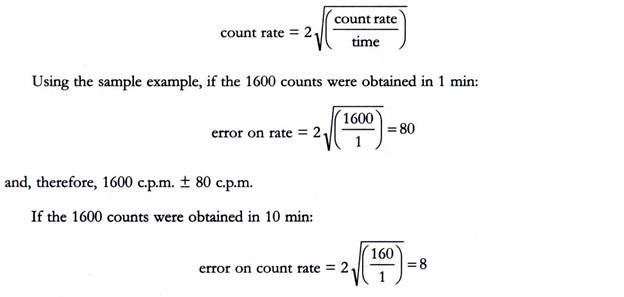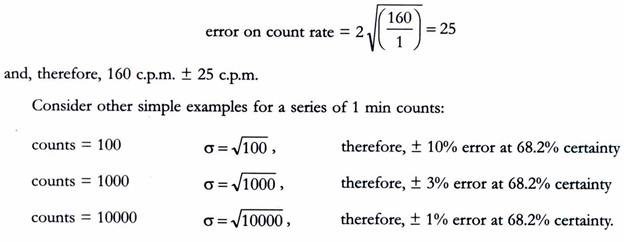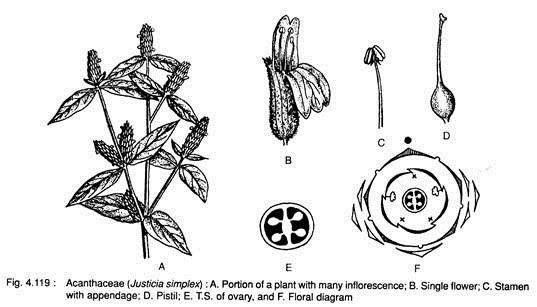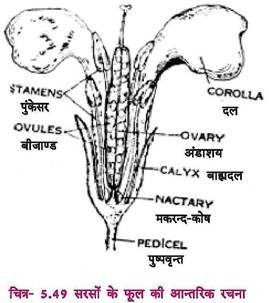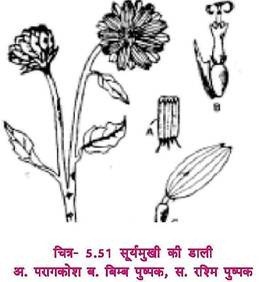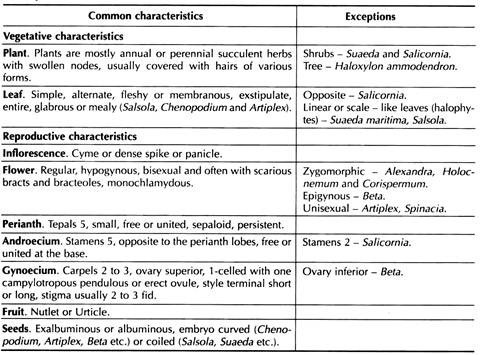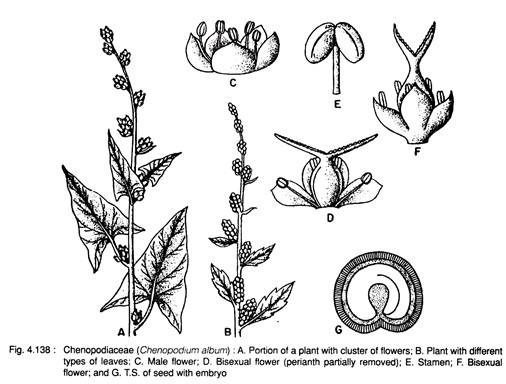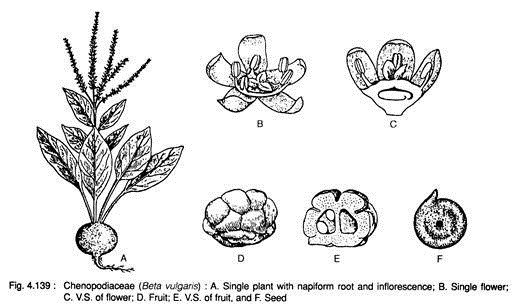ADVERTISEMENTS:
Here is an essay on the ‘Families of Dicotyledons’ for class 11 and 12. Find paragraphs, long and short essays on the ‘Families of Dicotyledons’ especially written for school and college students.
Essay on Dicotyledons
Essay Contents:
- Essay on Scrophulariaceae (Snapdragon Family)
- Essay on Acanthaceae (Acanthus Family)
- Essay on Verbenaceae (Verbain Family)
- Essay on Chenopodiaceae (Beet Family)
ADVERTISEMENTS:
Essay # 1. Scrophulariaceae (Snapdragon Family) :
ADVERTISEMENTS:
The family is represented by about 220 genera and 3,000 species found in different climatic conditions and grows abundantly in temperate regions of the world. About 57 genera and more than 350 species occur mainly in the Himalayan range of India.
The type genus of the family is Scrophularia.
Systematic Position:
Identifying Characteristics:
1. Plants are usually herbs or under-shrubs.
2. Leaves simple, exstipulate, opposite to alternate.
3. Inflorescence racemose or cymose.
4. Flowers are commonly zygomorphic.
5. Corolla – usually personate.
6. Stamens-4, didynamous (rarely 5 or 2).
7. Carpel-2, syncarpous and medianly placed, 2-chambered with many ovules on axile placentation.
ADVERTISEMENTS:
8. Fruit usually capsule.
Scrophulariaceae: Distinctive Features:
Floral Formula:
Phylogeny and Systematic:
The family is very closely related with Solanaceae. Due to close similarity between tribe Verbasceae of Scrophulariaceae and Salpiglossideae of Solanaceae, the Salpiglossideae is sometimes included in Scrophulariaceae by some taxonomists.
ADVERTISEMENTS:
Bentham and Hooker placed the natural order Scrophulariaceae under the cohort Personales, series Bicarpellatae, subclass Gamopetalae of class Dicotyledons. Engler placed the family under the order Tubiflorae, subclass Metachla-mydeae of class Dicotyledoneae. Later, Hutchinson placed it under the order Personales, division Herbaceae and subphylum Dicotyledones.
Common Plants:
1. Bacopa monnieri (L.) Wetts. (Syn. Herpestis monnieria H.B. & K.);
2. Dopatrium junceum Ham.;
3. Lindenbergia indica (L.) O. Kuntze. (Syn. L. urticaefolia Link & Otto.);
4. L. polyantha Royle;
ADVERTISEMENTS:
5. Limnophyla heterophylla (Roxb.) Benth. – an aquatic herb showing heterophylly;
6. Linaria ramosissima Wall.;
7. Lindernia ciliata (Colsm.) Pennel (Syn. Bonnaya brachiata Link and Otto.);
8. L. crustacea (Linn.) F. Muell. (Syn. Vandellia crustacea Benth.);
9. Scoparia dulcis L.;
10. Torenia cordata (Griff.) Dutta;
ADVERTISEMENTS:
11. Verbascum coromandelianum O. Ktze. (Syn. Celsia coromandeiiana Vahl.)
Key to Genera:
I. Corolla tubular, tube saccate to spurred; capsule opening by pores; inflorescence uniform:
i. Corolla spurred; anther-cells distinct…… Linaria.
ii. Corolla large, saccate below….. Antirrhinum.
II. Corolla personate, with 2 parallel ridges:
i. Calyx campanulate, 5-partite, equal; stamens all perfect; seeds angular; plants usually aquatic with sub- merged leaves multifid … Limnophila.
ii. Calyx campanulate, 5-fid; anther-cells disjoined; capsule loculicidal … ……………Lindenbergia
III. Corolla distinctly bilabiate; the anther-cells contiguous but distinct; calyx wide campanulate, 2-fid…………………………… Mazus.
IV. Corolla 5- lobed, without parallel ridges:
i. Calyx 5-partite, imbricate; stamens inserted; anther-cells contiguous; corolla white, tinged with purple and yellow; creeping or erect… Herpestis.
ii. Calyx deeply 5-fid; corolla-throat much widened; stamens 2 perfect, 2 staminodes; flowers violet; annual marshy herbs…………………. Dopatrium.
iii. Calyx 5-toothed; 2 stamens attached to upper lobes, the other 2 stamens to lower lobes, all anthers conniving or cohering in pair……………….. Lindernia.
iv. Calyx tubular, sometimes winged or obliquely 2-lipped; stamens 4, didynamous; flowers showy; fruit a linear……….. capsule……………………… Torenia.
v. Calyx segments 5; stamens 2, both perfect; capsule long……….. Bonnaya.
V. Corolla-lobes 4, rotate, white, almost regular; stamens 4, perfect with staminal hairs; fruit a small globular capsule with free central placenta………………………………… Scoparia.
VI. Corolla-lobes 5, rotate; calyx partite; stamens equal; anthers sagittate or horseshoe-shaped……………………………….. Hemiphragma.
VII. Corolla-lobes 5, subovate, with two upper lobes exterior in bud; stamens 4; leaves all alternate…………………………………………….. Celsia.
VIII. Corolla tubular, with spreading limbs, abruptly incurved; calyx subcampanulate, 5-toothed; ovary 1-celled, tip mucronate………………….. Striga.
Genus Lindernia:
Key to Lindernia:
1. Perfect stamens 2………………………………………………………………. ciliata-
2. Perfect stamens 4
i. Flowering calyx cleft down to the middle or less………………………………….. crustacea.
ii. Flowering calyx cleft down to the base or nearly so…………………………………… viscosa.
Plants of Economic Importance:
The plants of this family are of limited importance based on economic point of view. A few plants have medicinal and ornamental value.
A. Medicinal Plants:
1. Bacopa monnieri. The extract of the plants are used to control insanity and epilepsy. It is also used as nerve tonic.
2. Digitalis purpurea. The alkaloid ‘digitalin’ is extracted from the fully mature leaves and is used in the treatment of heart troubles. It has also some toxic effects like drowsiness and headache.
3. Picrorhiza kurroa. The medicine picrorhiza is extracted from the dried rhizomes. It acts as cathartic, laxative and stomachic.
4. Scoparia dulcis (Sweet Broom-weed). The extract of the leaves is used in the treatment of bronchitis, cough and fever.
5. Torenia polygonoides. The extract of the plant is used as a poultice on ulcers and also on sores.
B. Ornamental Plants:
1. Antirrhinum majus (Snapdragon).
2. Calceolaria scabiosaefolia (Slipperwort).
3. Digitalis purpurea (Common foxglove).
4. Linaria vulgaris.
5. Mimulus luteus (Monkey flower).
6. Nemesia versicolor (Nemesia).
7. Russelia equisetiformis (Coral blow).
8. Torenia asiatica.
Essay # 2
. Acanthaceae (Acanthus Family) :
The family is represented by 256 genera and 2,765 species, mostly in the tropical parts and some are also found in the temperate regions of the world. The family is represented in India by about 68 genera and 337 species found to grow mostly in the hilly regions of tropical and subtropical Himalayas and also in western and southern regions.
The type genus of the family is Acanthus.
Systematic Position:
Identifying Characteristics:
1. Plants herbs or shrubs.
2. Stem with swollen nodes.
3. Leaves simple, exstipulate.
4. Flowers bisexual, zygomorphic, hypogynous with copious bracts and bracteoles.
5. Corolla usually bilabiate or semi- bilabiate.
6. Stamens usually 4, didynamous, epipetalous.
7. Carpels-2, syncarpous, style terminal.
8. Fruit bilocular capsule.
9. Seeds are non-endospermic and are situated on hook-like outgrowths — the jaculator or retinacula.
Floral Formula:
Acanthaceae: Distinctive Features:
Phylogeny and Systematic:
The family Acanthaceae is closely related to Boraginaceae, Scrophulariaceae, Labiatae and Verbenaceae.
Bentham and Hooker placed the natural order Acanthaceae under the cohort (=order) Personales, series Bicarpellatae, subclass Gamopetalae of class Dicotyledons.
Engler placed it under the order Tubiflorae, subclass Metachlamydeae of the class Dicotyledoneae. On the other hand, Hutchinson placed the family under the order Boraginales, division Herbaceae of subphylum Dicotyledones. Takhtajan and Cronquist placed the family under Scrophulariales.
Airy shaw (1973) included the genera Thunbergia, Meyenia, Pseudocalyx and Poun- guia in a separate family Thunbergiaceae and Mendoncia and Gilletiella in Mendonciaceae.
Common Plants:
1. Adhatoda vasica Nees;
2. Andrographis paniculata Nees;
3. Asterocanthus longifolius Nees (Syn. Hygrophyla spinosa T. And.);
4. Asystasia gangetica T. And.;
5. Barleria cristata L.;
6. B. prionitis L.;
7. Cardanthera triflora Ham.;
8. Daedalacanthus platiferus Gamble (Syn. Eranthemum platiferum Nees);
9. Dipterocanthus suffruticosus Voigt non Torr. (Syn. Ruellia suffruticosa Roxb.);
10. D. tuberosus Nees (Syn. Ruellia tuberosa L.);
11. Ecbolium viride (Fork) Alston. (Syn. E. linne- anum Kurz.);
12. Hemigraphis hirta T. And.;
13. Justicia diffusa Willd.;
14. J. simplex Don;
15. Micranthus oppositifolius Wendl. (Syn. Phaylopsis parviflora Willd);
16. Nelsonia campestris R. Br.;
17. Peristrophe bicalyculata Nees;
18. Rostellularia procumbens Nees (Syn. Justicia procumbens Nees);
19. Rungia parviflora Nees.
Key to Genera:
I. Corolla-lobes imbricate in bud; ovules numerous in two long rows; seeds mounted in papilla:
1. Stamens 2; calyx 4-sect; herbaceous bracts…………………… Nelsonia
2. Stamens 4; calyx 5-partite … Ebermaiera.
II. Corolla-lobes imbricate; jaculators curved; anthers 2-1-celled, often spurred at the base:
1. Ovules 3-10 in each cell; capsule more or less few-seeded, compressed at right angles to septum; flowers panicled……………………….. Andrographis.
2. Ovules 2-1 in each cell; corolla-lobes subequal; stamens 4, of which 2 are small or obsolete
i. Anthers 2-celled………………… Barleria.
ii. Anthers 1-celled…………. Crossandra.
iii. Anthers 2-celled, all equal, calyx deeply 5- or 4-lobed … Lepidagathis.
iv. Anthers 2-celled; stamens 4; corolla tube long; limb enlarged …Asystasia.
v. Anthers 2-celled; stamens 2; placenta originating from the base:
(a) Single-sided bracts, spicate; short- stalked capsule……. Rungia.
(b) Clustered bracts, 2 unequal; flowers shortly pedicellate; club-shaped capsule; calyx 5-partite … Dicliptera.
vi. Anthers 2-celled; one placed above the other, lower minutely spurred at the base; herbs or shrubs… Justicia.
vii. Anthers 2-celled, apiculate, scarcely spurred; corolla 2-lipped, short- tubed; bracts leafy; placentae not originating from the base of the capsule…………………………………. Adhatoda.
(a) FIs. long, narrow, clustered; bracts narrow, small; plants usually shrubs ………………………… Rhinacanthus.
(b) FIs. in axillary or terminal clusters; bracts larger than the bracteoles in opposite valvate pairs; corolla rose or purple; plants spreading herbs ………………………… Peristrophe.
3. Ovules 2 in each cell; stamens 2 —
i. Corolla cylindric, widened at the base; anther-cells parallel, equal with widened connective … Eranthemum.
ii. Corolla tube long, filiform; anther- cells parallel, subequal; large bracts imbricated ……………… Ecbolium.
III. Corolla-lobes twisted in bud:
1. Stamens 4, didynamous; bracts large, foli- aceous; ovules in collateral pairs in each cell; fruit beaked capsule; jaculaor absent; plant usually a climber with yellow or blue flowers …………. Thunbergia.
2. Stamens 4, didynamous; seeds mounted on jaculator; style 2-fid, one lobe often suppressed
i. Ovules 3-12 in each cell:
(a) Corolla 2-lipped; flowers sessile, axillary, lower leaves often toothed; jaculator not hooked … Cardenthera.
(b) Corolla 2-lipped; flowers subsessile, axillary; leaves entire; jaculator hooked; capsule narrow; spinescent herb ……………. Hygrophila.
(c) Corolla regular, 5-lobed; large bracteole; stamens muticous; clavate capsule with solid base ……………… Ruellia.
(d) Corolla 5-lobed; bracteole small or absent; flowers capitate; capsule with seeds from the base…………………………….. Hemigraphis.
ii. Ovules 2 in each cell:
(a) Corolla 5-lobed; stamens 4 or 2; anthers muticous; placenta from the base of the capsule … Strobilanthes.
(b) Corolla 5-lobed, slightly unequal; stamens 4, didynamous; anthers 2- celled, parallel, base mucronate; placenta from the base of the capsule ………………. Phaylopsis.
IV. Corolla-lobes short, upper lip reduced, lower one 3-lobed; ovules 2 in each cell; jaculator curved and hardened; anterior filaments with process ……………….. Acanthus.
Plants of Economic Importance:
The plants of this family are of limited importance from the economic point of view. A few plants have medicinal and ornamental value.
A. Medicinal Plants:
1. Adhatoda vasica (Vasaka). The extract of leaves is used for the remedy of asthma, cough and bronchitis.
2. Andrographis paniculata (Kalmegh). The extract of the leaves is used to control liver troubles. The leaves are pasted and made into small tablets that are used in the morning to control small threadworms of human intestine.
3. Barleria prionitis (Kala bansa), B. cristata, B. buxifolia and B. longifolia. The extract of leaves and roots are used for the remedy of cough and also inflammations.
4. Ecbolium viride. The roots are used to control jaundice.
5. Asterocanthus longifolius (Kuleykhara). The extract of the leaves and roots are used to control rheumatism and jaundice. The extract of young leaves along with stem prepared after boiling with water and taken in the morning that caused increase in hemoglobin content of the blood.
6. Phlogacanthus thyrsiflorus. The fruits and leaves are used as febrifuge (any medicine that cures fever).
B. Ornamental Plants:
Several species are cultivated in the garden as ornamental plants.
These are:
1. Beloperone guttata (Shrimp plant).
2. Barleria cristata, B. gibsoni, B. lupulina,
B. montana, B. noctiflora, B. polythelia and B. prionitis.
3. Eranthemum bicolor, E. nervosum and E. reticulatum.
4. Jacobinia tinctoria.
5. Justicia gendarussa.
6. Ruellia prostata and R. brittoniana.
7. Strobilanthes isophyllus.
8. Thunbergia alata, T. coccinea, T. grandi- flora and T. laurifolia.
Essay # 3
. Verbenaceae (Verbain Family) :
The family is represented by 36 genera and 1,035 species grows commonly in the tropical and subtropical regions of the world. About 21 genera and 125 species are found to grow in the tropical and subtropical Himalayas and also in the Western and Southern regions of India.
The type genus of the family is Verbena.
Systematic Position:
Verbenaceae: Distinctive Features:
Identifying Characteristics:
1. Plants herbs, shrubs or tree.
2. Leaves simple (sometimes compound), exstipulate, arranged in opposite or whorled phyllotaxy.
3. Inflorescence-racemose or cymose or cymose panicle.
4. Flowers bisexual, zygomorphic, hypogynous, bracteate.
5. Sepals 5, persistent.
6. Corolla tubular or bilabiate, often oblique.
7. Stamens commonly 4, didynamous.
8. Carpel 2, syncarpous, ovules 1 in each chamber on axile placentation.
9. Fruit drupe.
Floral Formula:
Phylogeny and Systematic:
The family is closely related with Labiatae. Bentham and Hooker placed the Natural Order (= Family) under the Cohort (=order) Lamiales series Bicarpellatae, subclass Gamopetalae of class Dicotyledons.
Engler and Prantl placed the family under order Tubiflorae, subclass Metachlamydeae of class Dicotyledoneae. On the other hand, Hutchinson placed the family under the order Verbenales, division Lignosae of sub-phylum Dicotyledones.
The genus Avicennia that was included by Bentham and Hooker in Verbenaceae was also retained by Hutchinson, Takhtajan, Cronquist and many others. But taxonomists like Eichler, Airy Shaw and some others placed it in a separate family Avicenniaceae.
The family is considered to be nearly related to Lamiaceae but taxonomists like Hutchinson considered it to be unrelated to Lamiaceae and have been derived from Rubiaceous stock.
Common Plants:
1. Avicennia officinalis L.;
2. Callicarpa macrophylla Vahl ;
3. Clerodendrum viscosum Vent. (Syn. Clero- dendron infortunatum Gaertn.);
4. C. indicum (L.) Kuntz. (Syn. C. siphonanthus R. Br.);
5. C. inerme L.;
6. Duranta repens L. (Syn. D. plumieri Jacq.);
7. Gmelina arborea L. (Syn. Premna arborea Roth.);
8. Lantana camara L. var. aculeata (L.) Mold. (Syn. Lantana camara L.);
9. Lippia alba (Mill.) N.E. Br. ex Britt. and Wilson (Syn. L. geminate H.b. & K.);
10. Petrea volubilis Jacq;
11. Phyla nodiflora Green (Syn. Lippia nodiflora Rich.);
12. Premna integrifolia L.;
13. Tectona grand is L.
14. Verbena officinalis L. etc.
Key to Genera:
I. Inflorescence Racemose Centripetal Spicate:
Small flowers, sessile, clustered in heads, corolla 4 or 5 (2-lobed)—
i. Fruit drupe; 2 pyrenes; small calyx; shrubs ……………… Lantana.
ii. Fruit capsule, 2 pyrenes; small calyx; shrubs ………………. Lippia.
iii. Fruit separating into two 1-seeded pyrenes………………. Stachvtarpheta.
iv. Fruits pyrenes 4 or 1; calyx tubular, non-accrescent; herb ……….. Verbena.
v. Fruit fleshy, 2-seeded pyrenes ……………… Duranta.
II. Inflorescence Cymose, Centrifugal or Panicled:
a. Small flowers; corolla regular; stamens isomerous; leaves entire –
i. Flowers 4-6-merous; anthers exserted; fruit a drupe with 1, 4-celled pyrenes, enclosed in fleshy calyx ……………… Tectona.
ii. Flowers 4-merous; anthers exserted; fruit a round drupe with 4 pyrenes ……………. Callicarpa.
b. Small flowers; corolla 2-lipped; stamens didynamous –
1. Succulent drupe with single pyrene
i. Leaves entire or toothed…….. Premna.
ii. Leaves entire; flowers large 1 inch long ……….. Gmelina,
iii. Leaves digitate; 3-5 folded……… Vitex.
2. Fruit drupe with 4 pyrenes; leaves simple
i. Calyx bell-shaped; corolla tube long slender; stamens equal or didynamous; drupe round ………….. Clerodendrum.
ii. Calyx large, petaloid (red), rotate; usually a climbing or straggling shrub …………. Holmskioldia.
III. Inflorescence Capitate Cyme:
i. Bracts (involucral) 6 or 3-4; large; fruit usually dry; corolla 2-lipped; large climber ………….. Congea
ii. Calyx 5-partite, concave, imbricate; fruit fleshy capsule, 1-seeded; flowers small; shrubs with leathery leaves ……………. Avicennia.
Plants of Economic Importance:
This family is important for its timbers, and also for ornamental plants. A few are used for medicinal and other purposes.
A. Timber Yielding Plants:
1. Gmelina arborea (Candahar tree, Gambar). The timber of this plant is used for window panels, furniture, paper industry, match industry, shafts, bridges, boats etc.
2. Premna bengalensis. The wood of this plant is used in posts, bridges, and also for carving.
3. Tectona grandis (Teak, Segun). It is an important hard wood used in ship building, frame of doors and windows, cabinet work, bridge and other heavy constructions.
4. Vitex altissima. The wood of this plant is used in boats and other constructional works.
B. Ornamental Plants:
The following plants are cultivated in the garden as ornamental plants:
1. Caryopteris incana (blue-beard).
2. Clerodendrum fragrans, C. speciosum, C. inerme and C. indicum. These plants are commonly known as glory bower.
3. Duranta repens (Syn. D. plumeri). The plant is commonly known as golden dewdrop.
4. Holmskioldia sanguinea (Chinese hat- plant).
5. Lantana camara.
6. Petrea volubilis (Queen’s wreath).
7. Verbena bipinnatifida, V. bonariensis and V! hybrida.
C. Medicinal Plant:
1. Vitex negundo. The extract of the roots and leaves are used as tonic, febrifuge, and also as diuretic.
D. Other Uses:
1. Avicennia officinalis. The bark is used for tanning.
Essay # 4
. Chenopodiaceae (Beet Family) :
The family Chenopodiaceae consists of 106 genera and 1,425 species in different parts of the world. They are commonly found in Central and Eastern region of Asia, Australia, South Africa (Karroo) and also in the South West Caspian coast. In India, the family is represented by 20 genera and more than 50 species distributed widely from tropical to temperate Himalayas even up to height of 1,750 metres (5,750 ft).
The type genus of the family is Chenopodium.
Systematic Position:
Chenopodiaceae: Distinctive Features:
Identifying Characteristics:
1. Succulent herbs with swollen nodes.
2. Inflorescence. Cyme or dense spike or panicle.
3. Flower. Regular, hypogynous, bisexual and often with scarious bracts and bracteoles.
4. Perianth. Tepals 5, small, free or united, sepaloid, persistent.
5. Stamens 5 free or united at the base.
6. Carpels 2 to 3, ovary superior, 1-celled.
7. Fruit. Nutlet or Urticle; embryo curved or coiled.
Floral Formula:
Phylogeny and Systematic:
The family is closely related to Amaranthaceae which differs in having green and fleshy tepals.
Bentham and Hooker placed the Chenopodiaceae under the Series Curvembryeae, Subclass Monochlamydeae of Class Dicotyledons. Engler and Prantl included the family under the order Centrospermae, Subclass Archichlamydeae of Class Dicotyledones. Hutchinson, on the other hand, placed the family under Order Chenopodiales, Division Archi-chlamydeae of Subphyla Dicotyledones. Later, both Takhtajan and Cronquist placed the family under the Order Caryophyllales.
The two subfamilies Chenopodieae and Baselleae as segregated by Bentham and Hooker, are considered as separate families, Chenopodiaceae and Basellaceae by several taxonomists like Hutchinson, Takhtajan and Cronquist.
Common Plants:
1. Arthrocnemum indicum Moq. Woody and prostrate shrubs commonly grow in Sunder- bans.
2. Beta vulgaris L. (Sugar-beet),
3. Chenopodium album L. (Lambis quarters). Tall cultivated herb.
4. C. ambrosoides L. A Tall cultivated herb.
5. Salicornia brachiata Roxb. Woody and prostrate shrubs commonly grow in Sunder- bans.
6. Spinacia oleracea L. (Spinach). Commonly cultivated plant.
7. Suaeda maritima Dumort. Plants are found to grow on Saline soils.
Key to Genera:
I. Stem not Jointed:
1. Leaves fleshy; flowers minute, axillary, 2-sexual; stamens almost hypogynous ………… Suaeda.
2. Leaves membranous; flowers clustered; stamens perigynous –
i. Flowers all similar, 2-sexual
(a) Perianth 5-partite, hardly altered in fruit; flowers without bracts and bracteoles …Chenopodium.
(b) Perianth 5-lobed, base thickened in fruit; flowers bracteate …Beta.
ii. Flowers dissimilar, 1-sexual
(a) Male flowers in terminal spike; stamens 4-5; female flowers in axillary clusters, with 2-4 toothed perianth but without bracteole………………………………. Spinacia.
(b) Male flowers with 3-5 sepals; female flowers without perianth Artiplex.
II. Stem Joined; Leaves 0; Flowers Bisexual:
1. Flowers 2-6 in spike; perianth-mouth narrow, 3-4-fid…………. Arthrocnemum.
2. Flowers in 3, sunk in cavities near joints; perianth-mouth wide, truncate or with 3-4 minute teeth…………. Salicornia.
Plants of Economic Importance:
ADVERTISEMENTS:
The plants are of very little economic importance. Plants are used as vegetables, food, fodder and also as ornamental plants.
A. Vegetables:
1. Chenopodium album L. The plant is used as vegetable.
2. Spinacia oleracea L. (Spinach). Commonly used as vegetables.
B. Food:
1. Chenopodium quinoa L. The seeds are called equinoai, consumed as staple food like rice.
2. Beta vulgaris. The plants are used as food.
C. Fodder:
1. Artiplex hortensis L. (Salt bush). The plants are used as fodder.
2. Kochia sp. The plants are used as fodder.
3. Eurotia lanata (USA). The plants are used as fodder.
D. Oil:
1. Chenopodium anthelminticum. The oil extracted from seeds are used as a vermifuge.
E. Ornamental Plants:
1. Some species of Kochia are grown as ornamental plants.




